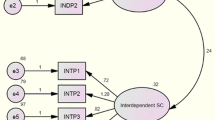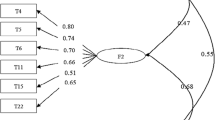Abstract
The self-expansion theory suggests that acquiring novel experiences, perspectives, and resources can expand people’s self-concepts (Aron & Aron, 1986). Many studies have demonstrated the implications of self-expansion for wellbeing in interpersonal and nonrelational contexts. Although scholars have proposed that self-expansion is a basic human motivation, research that supports its cross-cultural generalizability is limited. The present study aimed to contribute to the research (a) by validating a Chinese translation of the Self-Expansion Questionnaire (SEQ, Lewandowski & Aron, 2002) and the Individual Self-Expansion Questionnaire (ISEQ, Mattingly & Lewandowski, 2013)—the established measures of self-expansion in relational and nonrelational contexts, respectively; and (b) by assessing psychometric properties of a measure of the general self-expansion which modified and combined the SEQ and ISEQ. Study 1 conducted an online survey among 335 undergraduate students and examined the factor structures of the scales using exploratory factor analyses. Study 2 aimed to assess the scales among working adults (N = 327) and conducted a confirmatory factor analysis. Both the studies measured openness to experience, sensation seeking, and epistemic curiosity to test convergent validity of the self-expansion scales; and assessed their predictive validity by including self-efficacy, self-esteem, positive and negative affect, and life satisfaction. Findings of the two studies showed that the Chinese scales had good internal reliability and validity, suggesting their applicability to Chinese adult populations. We discussed possible differences in the self-expansion of Chinese and members of individualist cultures and provided questions for future research on general self-expansion.
Similar content being viewed by others
Data Availability
The datasets generated during and/or analysed during the current study are available from the corresponding author on reasonable request.
Code Availability
Not applicable
References
Aron, A., & Aron, E. (1986). Love and the expansion of the self: Understanding attraction and satisfaction. Hemisphere.
Aron, A., Aron, E. N., & Smollan, D. (1992). Inclusion of Other in the Self Scale and the structure of interpersonal closeness. Journal of Personality and Social Psychology, 63(4), 596–612. https://doi.org/10.1037/0022-3514.63.4.596
Aron, A., Norman, C. C., Aron, E. N., McKenna, C., & Heyman, R. E. (2000). Couples’ shared participation in novel and arousing activities and experienced relationship quality. Journal of Personality and Social Psychology, 78(2), 273–284. https://doi.org/10.1037/0022-3514.78.2.273
Aron, A., Paris, M., & Aron, E. N. (1995). Falling in love: Prospective studies of self-concept change. Journal of Personality and Social Psychology, 69(6), 1102–1112. https://doi.org/10.1037/0022-3514.69.6.1102
Aron, A., Lewandowski, G. W., Jr., Mashek, D., & Aron, E. N. (2013). The self-expansion model of motivation and cognition in close relationships. In J. A. Simpson & L. Campbell (Eds.), Oxford library of psychology. The Oxford handbook of close relationships (p. 90–115). Oxford University Press.
Bi, C., Oyserman, D., Lin, Y., Zhang, J., Chu, B., & Yang, H. (2020). Left behind, not alone: Feeling, function and neurophysiological markers of self-expansion among left-behind children and not left-behind peers. Social Cognitive and Affective Neuroscience, 15(4), 467–478. https://doi.org/10.1093/scan/nsaa062
Chen, X., Li, F., Nydegger, L., Gong, J., Ren, Y., Dinaj-Koci, V., Sun, H., & Stanton, B. (2013). Brief Sensation Seeking Scale for Chinese—Cultural adaptation and psychometric assessment. Personality and Individual Differences, 54(5), 604–609. https://doi.org/10.1016/j.paid.2012.11.007
Cui, J. H. (2013). Ziwo kuozhang yu tiaojie dingxiang dui qinmi guanxi yingxiang de yanjiu [The study of the relationship between self-expansion and regulatory focus in close relationships] [Master’s thesis, Southwest University]. CNKI China Master’s Theses Full-text Database.
Diener, E., Emmons, R. A., Larsen, R. J., & Griffin, S. (1985). The Satisfaction With Life Scale. Journal of Personality Assessment, 49(1), 71–75. https://doi.org/10.1207/s15327752jpa4901_13
Fisher, H. E., Xu, X., Aron, A., & Brown, L. L. (2016). Intense, passionate, romantic love: a natural addiction? How the fields that investigate romance and substance abuse can inform each other. Frontiers in Psychology, 7, Article 687. https://doi.org/10.3389/fpsyg.2016.00687
Fivecoat, H. C., Tomlinson, J. M., Aron, A., & Caprariello, P. A. (2015). Partner support for individual self-expansion opportunities: Effects on relationship satisfaction in long-term couples. Journal of Social and Personal Relationships, 32(3), 368–385. https://doi.org/10.1177/0265407514533767
Gordon, C. L., & Luo, S. (2011). The Personal Expansion Questionnaire: Measuring one’s tendency to expand through novelty and augmentation. Personality and Individual Differences, 51(2), 89–94. https://doi.org/10.1016/j.paid.2011.03.015
Graham, J. M. (2008). Self-expansion and flow in couples’ momentary experiences: An experience sampling study. Journal of Personality and Social Psychology, 95(3), 679–694. https://doi.org/10.1037/0022-3514.95.3.679
Guo, J. C. (2011). Ziwo jiegou de qidong dui ziwo kuozhang dongji shuiping de yingxiang shiyan yanjiu [The effects of self-construal priming on self-expansion moviation] [Master’s thesis, Southwest University]. CNKI China Master’s Theses Full-text Database.
Hambleton, R. K., Merenda, P. F., & Spielberger, C. D. (2004). Adapting educational and psychological tests for cross-cultural assessment. Erlbaum.
Hoyle, R. H., Stephenson, M. T., Palmgreen, P., Pugzles Lorch, E., & Donohew, R. L. (2002). Reliability and validity of a brief measure of sensation seeking. Personality and Individual Differences, 32(3), 401–414. https://doi.org/10.1016/S0191-8869(01)00032-0
Hu, L. T., & Bentler, P. M. (1999). Cutoff criteria for fit indexes in covariance structure analysis: Conventional criteria versus new alternatives. Structural Equation Modeling, 6(1), 1–55. https://doi.org/10.1080/10705519909540118
Huang, L., Yang, T. Z., & Ji, Z. M. (2003). Zhengxing fuxing qingxu liangbiao de zhongguo renqun shiyongxing yanjiu [Applicability of the Positive and Negative Affect Scale in Chinese]. Zhongguo Xinli Weisheng Zazhi, 17(1), 54–56.
Hughes, E. K., Slotter, E. B., & Lewandowski, G. W., Jr. (2020). Expanding who I am: Validating the Self-Expansion Preference Scale. Journal of Personality Assessment, 102(6), 792–803. https://doi.org/10.1080/00223891.2019.1641109
Jia, F. X. (2012). Ziwo kuozhang yu shijian weidu shang de guanxi manyidu pingjia de guanxi yanjiu [The study of the relationship between self-expansion and temporal relation-appraisal] [Master’s thesis, Southwest University]. CNKI China Master’s Theses Full-text Database.
Jia, F. X., & Shi, W. (2012). Ziwo kuozhang moxing de yanjiu shuping [A Review of Self-expansion Model]. Xinli Kexue Jinzhan, 20(1), 137–148.
Kashdan, T. B., Gallagher, M. W., Silvia, P. J., Winterstein, B. P., Breen, W. E., Terhar, D., & Steger, M. F. (2009). The Curiosity and Exploration Inventory-II: Development, factor structure, and psychometrics. Journal of Research in Personality, 43(6), 987–998. https://doi.org/10.1016/j.jrp.2009.04.011
Lai, X. L., Liu, X. L., & Li, L. (2018). Qinmi guanxi zhong de ziwo kuozhang [Self-expansion in close relationships]. Xinli Kexue Jinzhan, 26(12), 2170–2179.
Lewandowski, G. W., Jr., & Aron, A. (2002). The self-expansion scale: Construction and validation. Paper presented at the Third Annual Meeting of the Society of Personality and Social Psychology, Savannah, GA.
Lewandowski, G. W., Jr., & Ackerman, R. A. (2006). Something’s missing: Need fulfillment and self-expansion as predictors of susceptibility to infidelity. The Journal of Social Psychology, 146(4), 389–403. https://doi.org/10.3200/SOCP.146.4.389-403
Liu, Q., Huang, J., & Zhou, Z. (2020). Self-expansion via smartphone and smartphone addiction tendency among adolescents: A moderated mediation model. Children and Youth Services Review, 119(C). https://doi.org/10.1016/j.childyouth.2020.105590
Mao, J., Chiu, C. Y., Owens, B. P., Brown, J. A., & Liao, J. (2019). Growing followers: Exploring the effects of leader humility on follower self-expansion, self-efficacy, and performance. Journal of Management Studies, 56(2), 343–371. https://doi.org/10.1111/joms.12395
Markus, H. R., & Kitayama, S. (1991). Culture and the self: Implications for cognition, emotion, and motivation. Psychological Review, 98(2), 224–253. https://doi.org/10.1037/0033-295X.98.2.224
Mattingly, B. A., & Lewandowski, G. W., Jr. (2013). The power of one: Benefits of individual self-expansion. The Journal of Positive Psychology, 8(1), 12–22. https://doi.org/10.1080/17439760.2012.746999
Mattingly, B. A., & Lewandowski, G. W., Jr. (2014a). Broadening horizons: Self-expansion in relational and non-relational contexts. Social and Personality Psychology Compass, 8(1), 30–40. https://doi.org/10.1111/spc3.12080
Mattingly, B. A., & Lewandowski, G. W. (2014b). Expanding the Self Brick by Brick: Nonrelational Self-Expansion and Self-Concept Size. Social Psychological and Personality Science, 5(4), 484–490. https://doi.org/10.1177/1948550613503886
McIntyre, K. P., Mattingly, B. A., Lewandowski, G. W., Jr., & Simpson, A. (2014). Workplace self-expansion: Implications for job satisfaction, commitment, self-concept clarity, and self-esteem among the employed and unemployed. Basic and Applied Social Psychology, 36(1), 59–69. https://doi.org/10.1080/01973533.2013.856788
Niu, G. F. (2017). Wangluo ziwo kuozhan de gainian jiegou, celiang jiqi shizheng yanjiu [The conceptual structure and measurement of online self-expansion, and its empirical studies] [Doctoral dissertation, Central China Normal University]. CNKI China Doctoral Dissertations Full-text Database.
Pu, K. H. (2013). Daxuesheng ziwo kuozhan, ziwo gainian yu aiqing jidu de xianzhuang jiqi guanxi yanjiu [A study of the relationships between self-expansion, self-concept, and romantic jealousy among college students] [Master’s thesis, Yunnan Normal University]. CNKI China Master’s Theses Full-text Database.
Rosenberg, M. (1965). Society and the adolescent self-image. Princeton University Press.
Schwarzer, R., & Jerusalem, M. (1995). Optimistic self-beliefs as a resource factor in coping with stress. In S. E. Hobfoll & M. W. deVries (Eds.), NATO ASI series. Extreme stress and communities: Impact and intervention (p. 159–177). Kluwer Academic/Plenum Publishers. https://doi.org/10.1007/978-94-015-8486-9_7
Shedlosky-Shoemaker, R., Costabile, K. A., & Arkin, R. M. (2014). Self-expansion through fictional characters. Self and Identity, 13(5), 556–578. https://doi.org/10.1080/15298868.2014.882269
Tian, L. M. (2006). Rosenberg (1965) zizun liangbiao zhongwenban de meizhongbuzu [Shortcoming and merits of Chinese version of Rosenberg (1965) Self-Esteem Scale]. Xinlixue Tanxin, 26(2), 88–91.
Wang, M. C., Dai, X. Y., & Yao, S. Q. (2011). Zhongguo dawu renge wenjuan de chubu bianzhi III: Jianshiban de zhiding ji xinxiaodu jianyan [Development of the Chinese Big Five Personality Inventory (CBF-PI) III: Psychometric Properties of CBF-PI Brief Version]. Zhongguo Linchuang Xinlixue Zazhi, 19(4), 454–457.
Wang, C. K., Hu, Z. F., & Liu, Y. (2001). Yiban ziwo xiaonenggan liangbiao de xindu he xiaodu yanjiu [Evidences for Reliability and Validity of the Chinese Version of General Self Efficacy Scale]. Yingyong Xinlixue, 7(1), 37–40.
Watson, D., Clark, L. A., & Tellegen, A. (1988). Development and validation of brief measures of positive and negative affect: The PANAS scales. Journal of Personality and Social Psychology, 54(6), 1063–1070. https://doi.org/10.1037/0022-3514.54.6.1063
Xing, Z. J., Wang, X. Z., Jiao, L. P., Zhou, T. N., Zhang, R. K., Yu, X. Y., Li, Y. Y., Yu, L. H., & Ning, F. H. (2002). Jizhong changyong zichen zhuguan xingfugan liangbiao zai woguo chengshi jumin zhong de shiyong baogao [Report on several common self-reported subjective well-being scales used to citizens in China]. Jiankang Xinlixue Zazhi, 10(5), 325–326.
Xu, X., Floyd, A. H., Westmaas, J. L., & Aron, A. (2010). Self-expansion and smoking abstinence. Addictive Behaviors, 35(4), 295–301. https://doi.org/10.1016/j.addbeh.2009.10.019
Ye, S., Ng, T. K., Yim, K. H., & Wang, J. (2015). Validation of the Curiosity and Exploration Inventory–II (CEI–II) among Chinese university students in Hong Kong. Journal of Personality Assessment, 97(4), 403–410. https://doi.org/10.1080/00223891.2015.1013546
Zuckerman, M., Eysenck, S. B., & Eysenck, H. J. (1978). Sensation seeking in England and America: Cross-cultural, age, and sex comparisons. Journal of Consulting and Clinical Psychology, 46(1), 139–149. https://doi.org/10.1037/0022-006X.46.1.139
Funding
This work was supported by the research fund from MWOP Reserve at the Department of Applied Psychology of Lingnan University (#770056).
Author information
Authors and Affiliations
Corresponding author
Ethics declarations
Conflicts of Interest/Competing Interests
On behalf of all authors, the corresponding author states that there is no conflict of interest.
Ethics Approval
Approval was obtained from the ethics committee of Lingnan University. The procedures used in this study adhere to the tenets of the Declaration of Helsinki.
Consent to Participate
Informed consent was obtained from all individual participants included in the study.
Additional information
Publisher's note
Springer Nature remains neutral with regard to jurisdictional claims in published maps and institutional affiliations.
Rights and permissions
About this article
Cite this article
Liu, S., Peng, M. & Lewandowski, G.W. Psychometric evaluation of a Chinese translation of the relational and individual self-expansion scales. Curr Psychol 42, 12671–12681 (2023). https://doi.org/10.1007/s12144-021-02585-8
Accepted:
Published:
Issue Date:
DOI: https://doi.org/10.1007/s12144-021-02585-8




